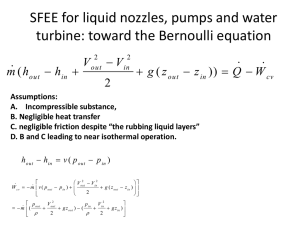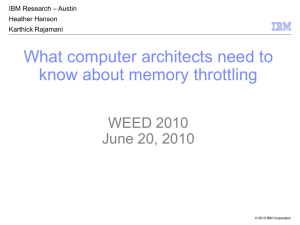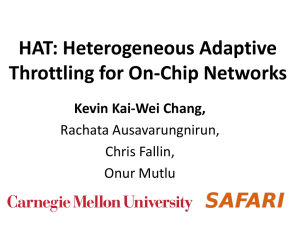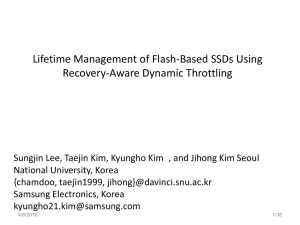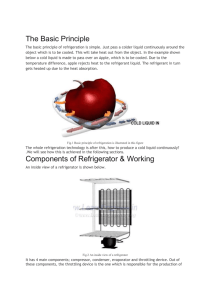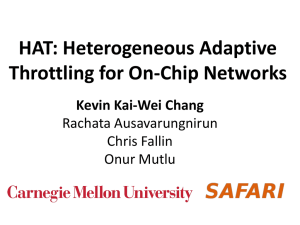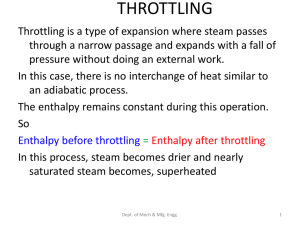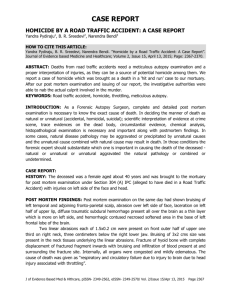HAT: Heterogeneous Adaptive Throttling for On-Chip Networks Kevin Kai-Wei Chang Rachata Ausavarungnirun
advertisement
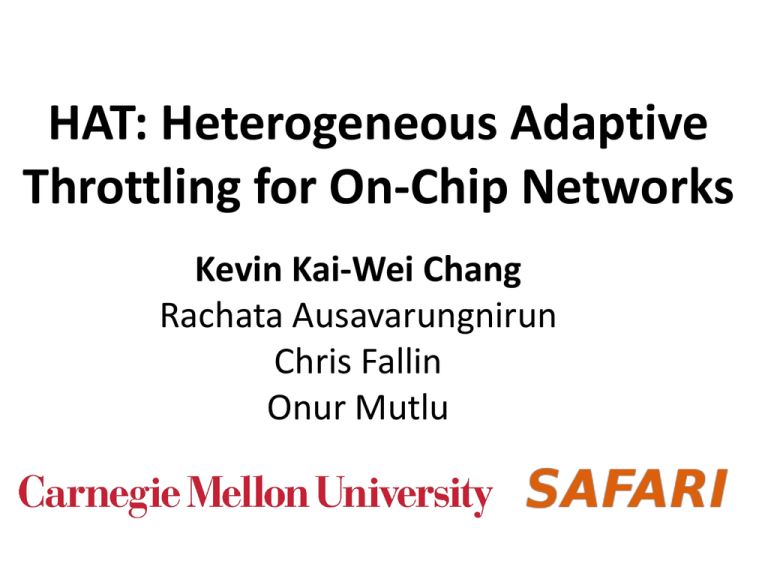
HAT: Heterogeneous Adaptive Throttling for On-Chip Networks Kevin Kai-Wei Chang Rachata Ausavarungnirun Chris Fallin Onur Mutlu Executive Summary Problem: Packets contend in on-chip networks (NoCs), causing congestion, thus reducing system performance Approach: Source throttling (temporarily delaying packet injections) to reduce congestion 1) Which applications to throttle? Observation: Throttling network-intensive applications leads to higher system performance Key idea 1: Application-aware source throttling 2) How much to throttle? Observation: There is no single throttling rate that works well for every application workload Key idea 2: Dynamic throttling rate adjustment Result: Improves both system performance and energy efficiency over state-of-the-art source throttling policies 2 Outline • Background and Motivation • Mechanism • Comparison Points • Results • Conclusions 3 On-Chip Networks PE PE PE … PE • Connect cores, caches, memory controllers, etc. – Buses and crossbars are not scalable IInterconnect PE Processing Element (Cores, L2 Banks, Memory Controllers, etc) 4 On-Chip Networks PE PE R PE PE PE PE R PE R PE R R PE R R • Connect cores, caches, memory controllers, etc R PE R R – Buses and crossbars are not scalable • Packet switched • 2D mesh: Most commonly used topology • Primarily serve cache misses and memory requests Router Processing Element (Cores, L2 Banks, Memory Controllers, etc) 5 Network Congestion Reduces Performance PE PE P R PE R P PE PE P R R Power, chip area, and timing PEP R Limited shared resources (buffers and links) • due to design constraints: R Network congestion: PE PE P R R PE system performance PE R R Router Packet P Processing Element (Cores, L2 Banks, Memory Controllers, etc) 6 Goal • Improve system performance in a highly congested network • Observation: Reducing network load (number of packets in the network) decreases network congestion, hence improves system performance • Approach: Source throttling (temporarily delaying new traffic injection) to reduce network load 7 Source Throttling PE PE P P … P P P P P P P P I PE P P P P P Long network latency when the network is congested I PE Network Packet P Processing Element (Cores, L2 Banks, Memory Controllers, etc) 8 Source Throttling P PE P P PE P P P P … P P P P P P P P P PE P I P P P P P • Throttling makes some packets wait longer to inject • Average network throughput increases, hence higher system performance I PE Network Packet P Processing Element (Cores, L2 Banks, Memory Controllers, etc) 9 Key Questions of Source Throttling • Every cycle when a node has a packet to inject, source throttling blocks the packet with probability P – We call P “throttling rate” (ranges from 0 to 1) • Throttling rate can be set independently on every node Two key questions: 1. Which applications to throttle? 2. How much to throttle? Naïve mechanism: Throttle every single node with a constant throttling rate 10 Key Observation #1 Throttling network-intensive applications leads to higher system performance Configuration: 16-node system, 4x4 mesh network, 8 gromacs (network-non-intensive), and 8 mcf (network-intensive) … gromacs P P P mcf P P P IP P P P Throttling gromacs decreases system performance by 2% due to minimal network load reduction 11 Key Observation #1 Throttling network-intensive applications leads to higher system performance Configuration: 16-node system, 4x4 mesh network, 8 gromacs (network-non-intensive), and 8 mcf (network-intensive) … gromacs P P P mcf P P P IP P P P Throttling mcf increases system performance by 9% (gromacs: +14% mcf: +5%) due to reduced congestion 12 Key Observation #1 Throttling network-intensive applications leads to higher system performance Configuration: 16-node system, 4x4 mesh network, 8 gromacs (network-non-intensive), and 8 mcf (network-intensive) … gromacs P P IP mcf P P reduces • Throttling network-intensive applications congestion Benefits both •• Throttling mcfnetwork-non-intensive reduces congestion and network-intensive applications • gromacs benefits more from less network latency 13 Key Observation #2 There is no single throttling rate that works well for every application workload … gromacs P P I gromacs … mcf P P P P mcf P I P P P P Network runs best at or below a certain network load Dynamically adjust throttling rate to avoid overload and under-utilization 14 Outline • Background and Motivation • Mechanism • Comparison Points • Results • Conclusions 15 Heterogeneous Adaptive Throttling (HAT) 1. Application-aware throttling: Throttle network-intensive applications that interfere with network-non-intensive applications 2. Network-load-aware throttling rate adjustment: Dynamically adjust throttling rate to adapt to different workloads and program phases 16 Heterogeneous Adaptive Throttling (HAT) 1. Application-aware throttling: Throttle network-intensive applications that interfere with network-non-intensive applications 2. Network-load-aware throttling rate adjustment: Dynamically adjust throttling rate to adapt to different workloads and program phases 17 Application-Aware Throttling 1. Measure applications’ network intensity Use L1 MPKI (misses per thousand instructions) to estimate network intensity 1. Throttle network-intensive applications How to select unthrottled applications? • Leaving too many applications unthrottled overloads the network Select unthrottled applications so that their total network intensity is less than the total network capacity Network-intensive (Throttled) Σ MPKI < Threshold Higher L1 MPKI App Network-non-intensive (Unthrottled) 18 Heterogeneous Adaptive Throttling (HAT) 1. Application-aware throttling: Throttle network-intensive applications that interfere with network-non-intensive applications 2. Network-load-aware throttling rate adjustment: Dynamically adjust throttling rate to adapt to different workloads and program phases 19 Dynamic Throttling Rate Adjustment • Different workloads require different throttling rates to avoid overloading the network • But, network load (fraction of occupied buffers/links) is an accurate indicator of congestion • Key idea: Measure current network load and dynamically adjust throttling rate based on load if network load > target: Increase throttling rate else: Decrease throttling rate If network is congested, throttle more If network is not congested, avoid unnecessary throttling 20 Heterogeneous Adaptive Throttling (HAT) 1. Application-aware throttling: Throttle network-intensive applications that interfere with network-non-intensive applications 2. Network-load-aware throttling rate adjustment: Dynamically adjust throttling rate to adapt to different workloads and program phases 21 Epoch-Based Operation • Application classification and throttling rate adjustment are expensive if done every cycle • Solution: recompute at epoch granularity During epoch: Every node: 1) Measure L1 MPKI 2) Measure network load Current Epoch (100K cycles) Beginning of epoch: All nodes send measured info to a central controller, which: 1) Classifies applications 2) Adjusts throttling rate 3) Sends new classification and throttling rate to each node Next Epoch (100K cycles) Time 22 Putting It Together: Key Contributions 1. Application-aware throttling – Throttle network-intensive applications based on applications’ network intensities 2. Network-load-aware throttling rate adjustment – Dynamically adjust throttling rate based on network load to avoid overloading the network HAT is the first work to combine application-aware throttling and network-load-aware rate adjustment 23 Outline • Background and Motivation • Mechanism • Comparison Points • Results • Conclusions 24 Comparison Points • Source throttling for bufferless NoCs [Nychis+ Hotnets’10, SIGCOMM’12] – Throttle network-intensive applications when other applications cannot inject – Does not take network load into account – We call this “Heterogeneous Throttling” • Source throttling for buffered networks [Thottethodi+ HPCA’01] – Throttle every application when the network load exceeds a dynamically tuned threshold – Not application-aware – Fully blocks packet injections while throttling – We call this “Self-Tuned Throttling” 25 Outline • Background and Motivation • Mechanism • Comparison Points • Results • Conclusions 26 Methodology • Chip Multiprocessor Simulator – 64-node multi-core systems with a 2D-mesh topology – Closed-loop core/cache/NoC cycle-level model – 64KB L1, perfect L2 (always hits to stress NoC) • Router Designs – Virtual-channel buffered router: 4 VCs, 4 flits/VC [Dally+ IEEE TPDS’92] • Input buffers to hold contending packets – Bufferless deflection router: BLESS [Moscibroda+ ISCA’09] • Misroute (deflect) contending packets 27 Methodology • Workloads – 60 multi-core workloads of SPEC CPU2006 benchmarks – 4 network-intensive workload categories based on the network intensity of applications (Low/Medium/High) • Metrics System performance: Fairness: Energy efficiency: IPC ishared Weighted Speedup alone IPC i i IPCialone Maximum Slowdown max i IPCishared PerfPerWatt WeightedSpeedup Power 28 Weighted Speedup Performance: Bufferless NoC (BLESS) 50 45 40 35 30 25 20 15 10 5 0 + 9.4% + 11.5% + 11.3% No Throttling Heterogeneous HAT + 7.4% + 8.6% HL HML HM Workload Categories H AVG 1. HAT provides better performance improvement than state-of-the-art throttling approaches 2. Highest improvement on heterogeneous workloads - L and M are more sensitive to network latency 29 Weighted Speedup Performance: Buffered NoC 50 45 40 35 30 25 20 15 10 5 0 No Throttling Self-Tuned Heterogeneous HAT HL HML HM Workload Categories H + 3.5% AVG HAT provides better performance improvement than prior approaches 30 Normalized Maximum Slowdwon (Lower is better) Application Fairness 1.2 No Throttling HAT Heterogeneous No Throttling Self-Tuned Heterogeneous HAT 1.2 1.0 - 15% 0.8 0.8 0.6 0.6 0.4 0.4 0.2 0.2 0.0 0.0 BLESS - 5% 1.0 Buffered HAT provides better fairness than prior works 31 Network Energy Efficiency No Throttling Normalized Perf. per Watt 1.2 + 8.5% HAT + 5% 1.0 0.8 0.6 0.4 0.2 0.0 BLESS Buffered HAT increases energy efficiency by reducing network load by 4.7% (BLESS) or 0.5% (buffered) 32 Other Results in Paper • Performance on CHIPPER [Fallin+ HPCA’11] – HAT improves system performance • Performance on multithreaded workloads – HAT is not designed for multithreaded workloads, but it slightly improves system performance • Parameter sensitivity sweep of HAT – HAT provides consistent system performance improvement on different network sizes 33 Conclusions Problem: Packets contend in on-chip networks (NoCs), causing congestion, thus reducing system performance Approach: Source throttling (temporarily delaying packet injections) to reduce congestion 1) Which applications to throttle? Observation: Throttling network-intensive applications leads to higher system performance Key idea 1: Application-aware source throttling 2) How much to throttle? Observation: There is no single throttling rate that works well for every application workload Key idea 2: Dynamic throttling rate adjustment Result: Improves both system performance and energy efficiency over state-of-the-art source throttling policies 34 HAT: Heterogeneous Adaptive Throttling for On-Chip Networks Kevin Kai-Wei Chang Rachata Ausavarungnirun Chris Fallin Onur Mutlu Throttling Rate Steps 36 Network Sizes 37 Performance on CHIPPER/BLESS Injection rate (number of injected packets / cycle): +8.5% (BLESS) or +4.8% (CHIPPER) 38 Multithreaded Workloads 39 Weighted Speedup Motivation 16 15 14 13 12 11 10 9 8 7 6 90% 94% Workload 1 Workload 2 80 82 84 86 88 90 92 94 Throttling Rate (%) 96 98 100 40 Sensitivity to Other Parameters • Network load target: WS peaks at b/w 50% and 65% network utilization – Drops more than 10% beyond that • Epoch length: WS varies by less than 1% b/w 20K and 1M cycles • Low-intensity workloads: HAT does not impact system performance • Unthrottled network intensity threshold: 41 Implementation • L1 MPKI: One L1 miss hardware counter and one instruction hardware counter • Network load: One hardware counter to monitor the number of flits routed to neighboring nodes • Computation: Done at one central CPU node – At most several thousand cycles (a few percent overhead for 100K-cycle epoch) 42
